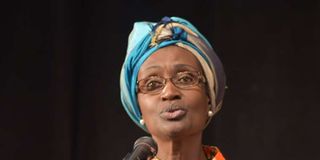UN calls for end to gender inequalities in HIV fight

UNAIDS Executive Director Winnie Byanyima.
What you need to know:
- Speaking at the University of Nairobi last week, Executive Director Winnie Byanyima called on leaders to tackle social inequalities and injustices and build fairer societies to end HIV-Aids.
- She noted that Kenya has recorded an increase in HIV infection for the first time in a decade, with more cases among girls and women than boys and men.
An official of a United Nations agency is pushing for an end to gender inequalities hindering the war on HIV-Aids.
United Nations Programme on HIV/Aids (UNAIDS) Executive Director Winnie Byanyima has called for equal access to medicines and health technologies for all genders. Speaking at the University of Nairobi last week, she called on leaders to tackle social inequalities and injustices and build fairer societies to end HIV-Aids.
“We need to have gender equality so that we can have an equal world where all have equal rights. There is also a need to have an end to the inequality in the global resources, calling for leaders to rethink unequal global financial architecture,” said Ms Byanyima.
She noted that Kenya has recorded an increase in HIV infection for the first time in a decade, with more cases among girls and women than boys and men. She observed that pandemics and ill health are rampant in unequal societies, hence the need to end the Aids injustice by 2030.
Also read: What world needs to do to end Aids
“For me, HIV is more than a disease; it is an injustice. With all we know from 40 years of this pandemic, the science, the drugs, the prevention tools, no one should be infected by HIV and no one should be dying from Aids-related causes. We can end the ugly inequalities driving HIV.”
According to UNAIDS data released in 2021, about 26 girls in Kenya are infected with HIV daily, with 4,200 girls and young women in sub-Saharan Africa being infected every week.
Risk factors
The UN agency attributes the infection majorly to high poverty levels. Ms Byanyima noted that HIV-Aids remains a crisis for adolescent girls and young women in Kenya, saying they are four times more likely to be infected than boys and men of the same age.
The agency’s data show women made up 65 per cent of new cases in sub-Saharan Africa and 52 per cent in the Caribbean. Roughly, 5,000 adolescent girls and young women aged 15 to 24 were facing infection every week, with adolescent girls living with HIV now outnumbering their male counterparts.
In 2020, a report by the National Aids Control Council showed young girls formed the bulk of new HIV cases in the country. It showed that 41,728 new cases were recorded, 25,062 of them being females and 16,666 males. Those aged 15 and above recorded 34,610 new cases, with 6,806 cases documented among children aged 14 or below.
Recent statistics from the National Aids and STI Control Programme show that about 1.5 million Kenyans are living with HIV, with 942,653 being women and 565,752 men.
The UN Women in 2020 released data that indicated women aged 15 and older accounted for more than 50 per cent of new HIV infection globally, for the first time. The number of new HIV cases, it notes, is also rising among women in Eastern Europe, Central Asia, the Middle East and North Africa.
“The Covid-19 pandemic has exacerbated the economic and social inequalities that drive such trends. Poverty and food insecurity, gender-based violence, stigma and discrimination, and child and forced marriage, all raise the risk of HIV infection for women and girls and limit their access to services,” the UN Women said in a statement.





